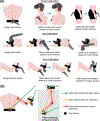Enhancing Mirror Therapy via Scaling and Shared Control: A Novel Open-Source Virtual Reality Platform for Stroke Rehabilitation
- PMID: 35600315
- PMCID: PMC9119151
- DOI: 10.1007/s10055-021-00593-4
Enhancing Mirror Therapy via Scaling and Shared Control: A Novel Open-Source Virtual Reality Platform for Stroke Rehabilitation
Abstract
Mirror therapy is increasingly used in stroke rehabilitation to improve functional movements of the affected limb. However, the extent of mirroring in conventional mirror therapy is typically fixed (1:1) and cannot be tailored based on the patient's impairment level. Further, the movements of the affected limb are not actively incorporated in the therapeutic process. To address these issues, we developed an immersive VR system using HTC Vive and Leap Motion, which communicates with our free and open-source software environment programmed using SteamVR and the Unity 3D gaming engine. The mirror therapy VR environment was incorporated with two novel features: (1) scalable mirroring and (2) shared control. In the scalable mirroring, mirror movements were programmed to be scalable between 0 and 1, where 0 represents no movements, 0.5 represents 50% mirroring, and 1 represents 100% mirroring. In shared control, the contribution of the mirroring limb to the movements was programmed to be scalable between 0 to 1, where 0 represents 100% contribution from the mirroring limb (i.e., no mirroring), 0.5 represents 50% of movements from the mirrored limb and 50% of movements from the mirroring limb, and 1 represents full mirroring (i.e., no shared movements). Validation experiments showed that these features worked appropriately. The proposed VR-based mirror therapy is the first fully developed system that is freely available to the rehabilitation science community. The scalable and shared control features can diversify mirror therapy and potentially augment the outcomes of rehabilitation, although this needs to be verified through future experiments.
Keywords: illusion; low cost; mirror neurons; motor control; telehealth; virtual rehabilitation.
Conflict of interest statement
Declarations Conflicts of interest/Competing interests: The authors declare no conflicts of interest
Figures









Similar articles
-
Feasibility and psychophysical effects of immersive virtual reality-based mirror therapy.J Neuroeng Rehabil. 2022 Oct 7;19(1):107. doi: 10.1186/s12984-022-01086-4. J Neuroeng Rehabil. 2022. PMID: 36207720 Free PMC article. Clinical Trial.
-
Proactive Motor Functional Recovery Following Immersive Virtual Reality-Based Limb Mirroring Therapy in Patients with Subacute Stroke.Neurotherapeutics. 2020 Oct;17(4):1919-1930. doi: 10.1007/s13311-020-00882-x. Neurotherapeutics. 2020. PMID: 32671578 Free PMC article.
-
Immersive Virtual Reality Mirror Therapy for Upper Limb Recovery After Stroke: A Pilot Study.Am J Phys Med Rehabil. 2019 Sep;98(9):783-788. doi: 10.1097/PHM.0000000000001190. Am J Phys Med Rehabil. 2019. PMID: 30964752 Free PMC article.
-
Effects of Immersive Virtual Reality on Upper-Extremity Stroke Rehabilitation: A Systematic Review with Meta-Analysis.J Clin Med. 2023 Dec 27;13(1):146. doi: 10.3390/jcm13010146. J Clin Med. 2023. PMID: 38202153 Free PMC article. Review.
-
Role of kinaesthetic motor imagery in mirror-induced visual illusion as intervention in post-stroke rehabilitation.Rev Neurosci. 2020 Aug 27;31(6):659-674. doi: 10.1515/revneuro-2019-0106. Rev Neurosci. 2020. PMID: 32229682 Review.
Cited by
-
Shaping corticospinal pathways in virtual reality: effects of task complexity and sensory feedback during mirror therapy in neurologically intact individuals.J Neuroeng Rehabil. 2024 Sep 4;21(1):154. doi: 10.1186/s12984-024-01454-2. J Neuroeng Rehabil. 2024. PMID: 39232841 Free PMC article.
-
Feasibility and psychophysical effects of immersive virtual reality-based mirror therapy.J Neuroeng Rehabil. 2022 Oct 7;19(1):107. doi: 10.1186/s12984-022-01086-4. J Neuroeng Rehabil. 2022. PMID: 36207720 Free PMC article. Clinical Trial.
-
Limitations and solutions of low cost virtual reality mirror therapy for post-stroke patients.Sci Rep. 2023 Sep 7;13(1):14780. doi: 10.1038/s41598-023-40546-2. Sci Rep. 2023. PMID: 37679388 Free PMC article.
References
-
- Abbink DA, Mulder M, Boer ER (2012) Haptic shared control: Smoothly shifting control authority? Cogn Technol Work 14:19–28. 10.1007/s10111-011-0192-5 - DOI
Grants and funding
LinkOut - more resources
Full Text Sources
